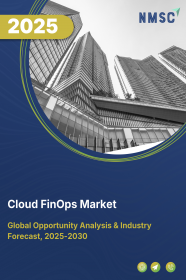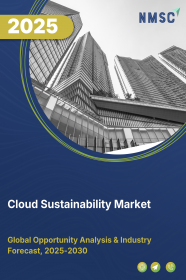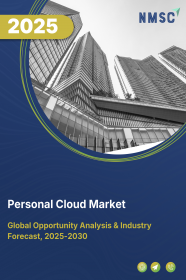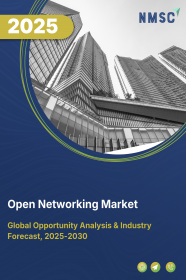
Cloud FinOps Market by Offering (Solutions and Services), by Service Model (Infrastructure-as-a-Service, and Others), by Deployment Model (Public Cloud, Private Cloud, and Others), by Organization Size (Large Enterprises and Small & Medium Enterprises), by Application (Cost Management & Optimization and Others), by End-User Industry (Banking, Financial Services, and Insurance and Others) – Global Opportunity Analysis and Industry Forecast 2025–2030
US Tariff Impact on Cloud FinOps Market
Trump Tariffs Are Reshaping Global Business
Cloud FinOps Industry Overview
The global Cloud FinOps Market size was valued at USD 9.79 billion in 2024 and is predicted to reach USD 11.10 billion by the end of 2025. The industry is predicted to reach USD 20.87 billion by 2030 with a CAGR of 13.5% from 2025 to 2030.
The market is experiencing significant growth as enterprises face increasing pressure to maintain real-time financial oversight amid rising cloud adoption. As organizations scale their cloud infrastructure, particularly with AI and high-performance workloads, the need for cost accountability has never been more crucial. Cloud cost optimization provides a structured approach to optimize cloud expenditure without sacrificing performance, offering enhanced visibility into spending and enabling better financial governance.
The widespread adoption of FinOps frameworks, like the FinOps Foundation, along with advanced tools for anomaly detection and automated cost allocation, is driving efficiency across multi-cloud and hybrid environments. Despite challenges such as the shortage of skilled practitioners and integration barriers, AI-powered solutions are transforming optimization strategies. It is done through enabling real-time cost management and predictive analytics, creating ample growth opportunities for both market players and enterprises striving for improved cloud ROI.
Rising Need for Cloud Cost Accountability Across Enterprises Drive Market Growth
The shift to cloud-native infrastructure has amplified the demand for real-time financial oversight. According to the 2024 State of FinOps Report by Cloudkeeper, over 60% of FinOps practitioners cite “unit cost tracking” as a top priority. Enterprises now seek granular visibility into who is spending, where, and why. As cloud budgets soar, especially with AI workloads consuming high-performance compute and storage, FinOps provides a structure to optimize expenditure without compromising performance. Google Cloud’s whitepaper (2024) also highlights how FinOps helps track business-aligned metrics, ensuring financial governance across departments.
Growing Adoption of FinOps Frameworks and Tools Drive Cloud FinOps Market Growth
The adoption of the FinOps foundation framework is accelerating as organizations mature their cloud cost optimization practices. This framework, outlined by FinOps.org, is now a standard across AWS, Azure, and GCP deployments. New capabilities such as “automated anomaly detection” and “cost allocation by team or workload” are gaining traction. According to Intel’s 2023 analysis, companies leveraging FinOps tools reported up to 30% improvement in cloud ROI within one year. Tools like Flexera One, CloudHealth by VMware, and Kubecost are integrating with CI/CD pipelines and DevOps platforms to bring financial operations closer to engineering workflows, thus driving the Cloud FinOps market expansion.
Expansion of Hybrid and Multi-Cloud Environments Fuels the Market Growth
Organizations increasingly operate across multiple cloud providers for redundancy, compliance, or performance reasons. This multi-cloud complexity amplifies the need for unified FinOps strategies. A 2025 report by Flexera states that 87% of organizations have a multi-cloud strategy, but only 22% have effective cost governance in place. FinOps offers a path to manage financial visibility across platforms like AWS, Azure, GCP, and Kubernetes clusters, ensuring consistent accountability. As AI and edge computing adoption rise, the FinOps approach becomes integral to keeping cloud sprawl and financial leakage under control.
Lack of Skilled FinOps Practitioners and Integration Barriers Hinder Industry Growth
The demand for certified FinOps professionals far exceeds supply. Job listings on platforms like BuiltIn and Capita show an increasing number of roles requiring expertise in both finance and cloud architecture. Moreover, integrating FinOps tools into existing tech stacks and workflows remains a technical hurdle, especially for legacy enterprises. Organizations without DevOps maturity may find it harder to realize the value of FinOps platforms.
AI-Powered FinOps Platforms Creates Opportunity for the Market Growth
AI and machine learning are supercharging FinOps capabilities by predicting cost spikes, automating budgeting, and offering proactive recommendations. Platforms such as ProsperOps and Sedai now offer autonomous cloud optimization, delivering real-time rightsizing and commitment management. In 2024, Google Cloud’s FinOps-X launch showcased new AI features for anomaly detection and spend forecasting. As data volumes and AI workloads expand, these intelligent solutions can significantly reduce waste and boost operational efficiency, creating a major growth lever for market players.
Most recently, in early 2025, CloudBolt unveiled its next-generation Augmented FinOps capabilities, which integrate generative AI and contextual automation to offer real-time spend visualization, guided remediation, and ROI analysis across hybrid and multi-cloud ecosystems. This platform uses telemetry and ML-based tagging to correlate cloud costs directly with business value, setting a new benchmark for intelligent cloud financial operations. As data volumes and AI workloads expand, these intelligent FinOps platforms are poised to significantly reduce cloud waste and enhance operational efficiency, offering a compelling growth lever for vendors and enterprise adopters alike.
Market Segmentation and Scope of the Study
The Cloud FinOps market report is segmented based on various factors including offering, service model, deployment model, organization size, application, end-use industry and regions. In terms of offering, the market is categorized into solutions, which include both native solutions and third-party solutions. Services, are divided into professional and managed services. Based on the service model, the market is classified into Infrastructure-as-a-Service (IaaS), Platform-as-a-Service (PaaS), and Software-as-a-Service (SaaS). Deployment model, the market is further segmented into public cloud, private cloud, and hybrid cloud.
The market is also segmented by organization further divided into large enterprises and small to medium enterprises (SMEs). In terms of application, the market includes cost management and optimization, budgeting and forecasting, cost allocation and chargeback, reporting and analytics, workload management and optimization, and other applications. Lastly, the market is segmented by end-user industry, covering sectors such as banking, financial services, and insurance (BFSI), information technology (IT) and telecom, retail and consumer goods, healthcare, manufacturing, government, and others. Geographic breakdown and analysis of each of the aforesaid segments includes regions comprising North America, Europe, Asia-Pacific, and RoW.
Geographical Analysis
North America continues to dominate the global industry in terms of industry size, thanks to early cloud adoption, advanced DevOps ecosystems, and a robust base of hyperscalers and FinOps vendors. The market share in this region is expanding rapidly as enterprises focus on financial accountability across multi-cloud environments. A key milestone was IBM's acquisition of Apptio in 2023 for USD 4.6 billion, followed by enhanced FinOps capabilities in Apptio Cloudability, enabling dynamic budgeting, forecasting, and Kubernetes cost insights. Platforms like ProsperOps and Kion are pioneering AI-powered rightsizing and commitment management, reshaping FinOps best practices. These developments are setting new benchmarks for real-time cloud optimization, helping U.S. firms streamline expenditures and maximize ROI, especially in sectors such as BFSI and IT.
In Europe, the cloud FinOps market share is gaining traction through a dual focus on regulatory compliance and sustainable cloud operations. The region’s growth potential is being amplified by the introduction of FOCUS 1.0, the FinOps Open Cost and Usage Specification, which standardizes billing formats across cloud service providers. Microsoft Azure also contributed to this movement in 2024 by enhancing Kubernetes namespace-level visibility and releasing FOCUS-compatible exports to support cost transparency. As more European enterprises adopt FinOps frameworks to align IT budgets with ESG goals, the demand for standardized cost optimization tools is expected to increase. Cloud vendors in the region are responding with tailored solutions that balance operational efficiency with environmental responsibility, reflecting a maturing FinOps market landscape.
The Asia-Pacific (APAC) region is emerging as a high-growth zone in the global market share, driven by escalating digital transformation across industries like telecom, retail, and manufacturing. As enterprises expand their cloud footprints, the need to manage and optimize spending has become critical. Google Cloud's 2024 launch of advanced AI-powered tools, featuring anomaly detection, committed use discount (CUD) management, and FinOps Hub enhancements has significantly influenced FinOps adoption in APAC. Notably, the inclusion of carbon emissions data into cloud cost tracking aligns with the region’s growing sustainability mandates. Countries such as India, Singapore, and Australia are witnessing rising FinOps adoption among both startups and large enterprises, signaling strong growth potential over the forecast period.
The Rest of the World, including regions such as Latin America, the Middle East, and Africa, is showing promising momentum in FinOps framework adoption. While the market size here is smaller compared to developed regions, increasing cloud penetration and cost-consciousness are driving demand for FinOps platforms. CloudBolt’s recognition in the 2024 GigaOm Radar Report and the introduction of its Augmented FinOps capabilities underscore this shift. Likewise, SoftwareOne’s extended partnership with Microsoft and AWS is enabling enterprises in these emerging markets to unlock new levels of visibility and control over their cloud expenditures. As awareness around FinOps principles continues to rise, industry players are positioning themselves to tap into these underpenetrated yet highly scalable markets.
Strategic Shifts Powering Cloud FinOps Evolution
Key players in the global cloud FinOps industry are actively deploying strategic partnerships, AI integration, and platform diversification to strengthen their market share and meet evolving enterprise demands. For instance, IBM’s acquisition of Apptio in 2023 marked a major consolidation move, enabling deeper multi-cloud financial operations and cost transparency across hybrid environments. Similarly, Google Cloud’s FinOps-X 2024 launch introduced AI-driven capabilities for spend forecasting and anomaly detection, reinforcing the trend toward predictive optimization.
Meanwhile, platforms like ProsperOps and Sedai are leveraging automation and machine learning to offer real-time rightsizing and commitment management, aligning with growing customer demand for autonomous cost control. Despite these innovations, the industry faces challenges such as lack of skilled FinOps professionals, inconsistent cloud billing formats, and complex multi-cloud cost structures.
However, these hurdles present growth opportunities, especially in the areas of FinOps-as-a-Service, platform interoperability, and sustainability-linked cost analytics. For example, Microsoft Azure’s alignment with FOCUS 1.0 standards and enhanced Kubernetes cost reporting reflects a clear opportunity to drive standardization and trust among enterprise users. As data volumes rise and organizations seek greater accountability in cloud spending, the growth potential for FinOps solutions continues to expand across global markets.
Key Benefits
-
The report provides quantitative analysis and estimations of the market from 2025 to 2030, which assists in identifying the prevailing market opportunities.
-
The study comprises a deep dive analysis of the market, including the current and future trends to depict prevalent investment pockets in the market.
-
Information related to key drivers, restraints, and opportunities and their impact on the market is provided in the report.
-
Competitive analysis of the players, along with their market share is provided in the report.
-
SWOT analysis and Porters Five Forces model is elaborated in the study.
-
Value chain analysis in the market study provides a clear picture of roles of stakeholders.
Cloud FinOps Market Key Segments
By Offering
-
Solutions
-
Native Solutions
-
Third-Party Solutions
-
-
Services
-
Professional Services
-
Managed Services
-
By Service Model
-
Infrastructure-as-a-Service (IaaS)
-
Platform-as-a-Service (PaaS)
-
Software-as-a-Service (SaaS)
By Deployment Model
-
Public Cloud
-
Private Cloud
-
Hybrid Cloud
By Organization Size
-
Large Enterprises
-
Small and Medium Enterprises (SMEs)
By Application
-
Cost Management & Optimization
-
Budgeting & Forecasting
-
Cost Allocation & Chargeback
-
Reporting & Analytics
-
Workload Management & Optimization
-
Others
By End-Use Industry
-
Banking, Financial Services, and Insurance (BFSI)
-
Information Technology (IT) & Telecom
-
Retail & Consumer Goods
-
Healthcare
-
Manufacturing
-
Government
-
Others
By Region
-
North America
-
The U.S.
-
Canada
-
Mexico
-
-
Europe
-
The UK
-
Germany
-
France
-
Italy
-
Spain
-
Denmark
-
Netherlands
-
Finland
-
Sweden
-
Norway
-
Russia
-
Rest of Europe
-
-
Asia Pacific
-
China
-
Japan
-
India
-
South Korea
-
Australia
-
Indonesia
-
Singapore
-
Taiwan
-
Thailand
-
Rest of Asia Pacific
-
-
RoW
-
Latin America
-
Middle East
-
Africa
-
Key Players
-
Amazon web services
-
Amdocs
-
Anglepoint, inc.
-
Bmc software
-
Capgemini
-
Datadog
-
Deloitte
-
Dot
-
Flexera
-
Google
-
Hitachi
-
Ibm
-
Lumen technologies
-
Microsoft
-
Nagarro
-
Nutanix
-
Oracle
-
Servicenow
-
Vmware
-
Cloudzero
REPORT SCOPE AND SEGMENTATION:
|
Parameters |
Details |
|
Market Size in 2024 |
USD 9.79 billion |
|
Revenue Forecast in 2030 |
USD 20.87 billion |
|
Growth Rate |
CAGR of 13.5% from 2025 to 2030 |
|
Analysis Period |
2024–2030 |
|
Base Year Considered |
2024 |
|
Forecast Period |
2025–2030 |
|
Market Size Estimation |
Billion (USD) |
|
Growth Factors |
|
|
Countries Covered |
28 |
|
Companies Profiled |
20 |
|
Market Share |
Available for 10 companies |
|
Customization Scope |
Free customization (equivalent up to 80 working hours of analysts) after purchase. Addition or alteration to country, regional, and segment scope. |
|
Pricing and Purchase Options |
Avail customized purchase options to meet your exact research needs. |

















 Speak to Our Analyst
Speak to Our Analyst




















